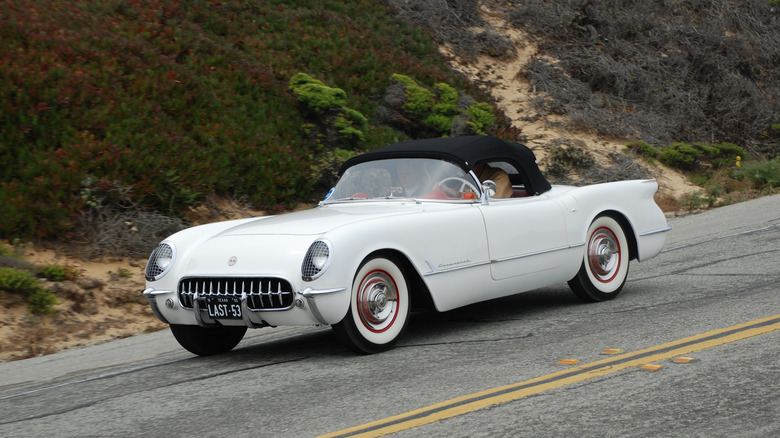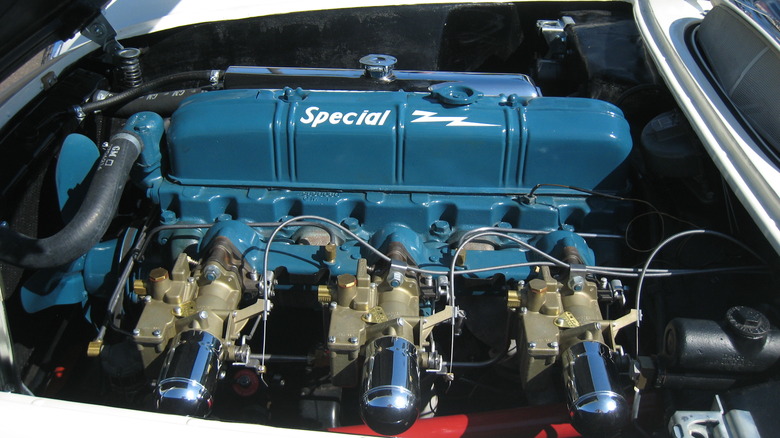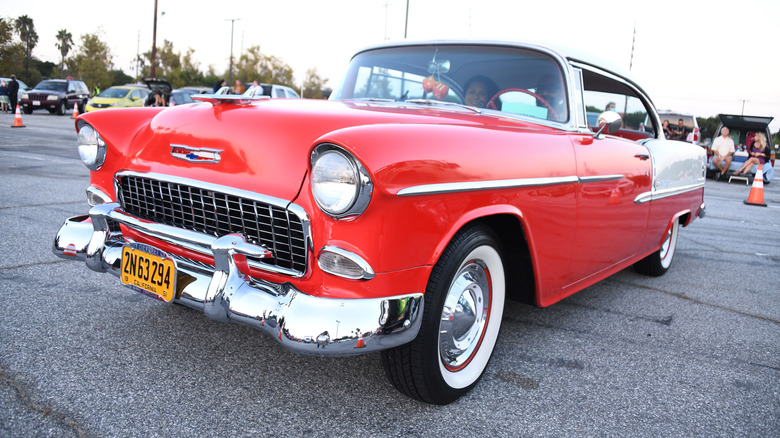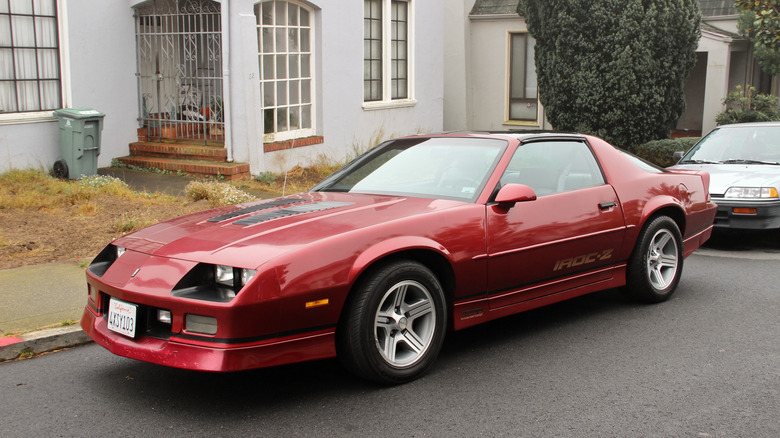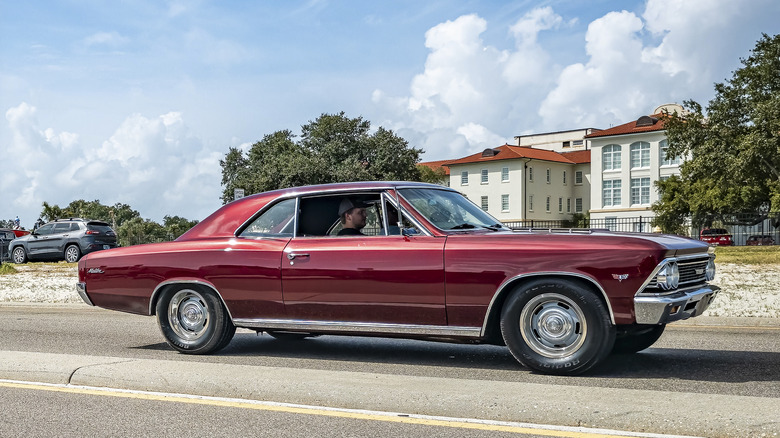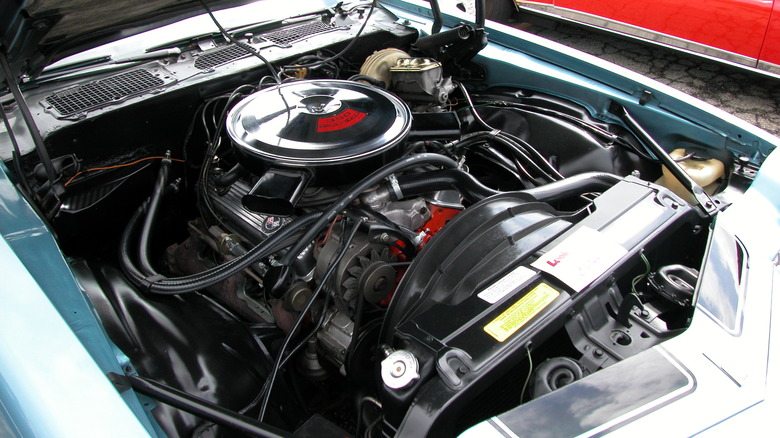6 Underrated Engines That Powered Some Of Chevrolet's Coolest Vehicles
In the many years since GM founder William Durant teamed up with Swiss race driver Louis Chevrolet to form a new automobile company, Chevy has manufactured more than 200 million vehicles. The brand has a tradition of innovation and market savvy. The 1915 Chevy 490 was introduced to compete with the Ford Model T, and Chevy sold 13,000 of them between June and the year's end. In 1935, Chevy started making the Suburban Carryall, an early SUV that has been on dealership lots every year since, making it the longest-running nameplate in automotive history. In 1953, the newly introduced Corvette revolutionized the sports car market, and the small-block V8 series of engines made its debut in 1955.
The small-block series was issued in a range of displacements from 262 to 400 cubic inches (4.3 to 6.6 liters), although the Chevy 350 was probably the most popular in the line. Later LS series engines became popular because of engine swaps. These powerplants all get plenty of well-deserved attention, but some of Chevrolet's coolest vehicles have been powered by lesser-known engines that deserve more attention and praise.
Blue Flame I6
The Corvette earned its reputation as a streetable sports car over its eight generations based largely on the powerful V8 engines that went under its pointed hood. However, the first 'Vette that Chevy sold in 1953 had a relatively anemic inline-six engine known as the "Blue Flame." The Corvette's 235 cubic-inch Blue Flame six-cylinder engine was based on the old Stovebolt Six and required three horizontally mounted Carter carburetors to get output up to 150 horsepower. Wringing Corvette-worthy performance out of an old truck engine also required beefing up the valve springs and water and fuel pumps and designing new intake and exhaust manifolds for better fuel and air flow. Chevy engineers even shielded the distributor to prevent radio interference (priorities were different seven decades ago).
These changes made it Chevy's most powerful I6 engine to that point, but the advent of the small-block series in 1955 led to the Blue Flame being extinguished for good the following year. It remains lost in the memory pile under the much more capable V8s that came behind it, but the Blue Flame I6 should be celebrated for bridging the gap between old and new engine technology, as well as for the creative tweaks Chevy engineers made to eke an acceptable amount of power from the obsolete Stovebolt Six.
[Featured image by Kowloonese via Wikimedia Commons|Cropped and scaled|CC-By 3.0]
265 V8
The smallest of the small-block Chevy V8s was the original 265 cubic-inch model that was first used in the 1955 Corvette and Bel Air. It initially came with three different fuel delivery options: a two-barrel carb that produced 162 horsepower, a four-barrel dual exhaust setup that upped output to 180 horses, and a "Super Power Pack" four-barrel option that added a direct-lift cam, better exhaust, and upgraded pistons. This configuration boosted the 265's output to 195 horsepower in 1955. The next year, checking the Super Power Pack box on the option sheet added another 30 horses to that number.
The special Power Pack cam was named after Corvette engineer and V8 evangelist Zora Arkus-Duntov. The 265 helped keep the Corvette alive in those early years, but the base version was barely strong enough to move the heavier models in Chevy's lineup, and it was soon devoured by larger V8s and the motoring public's desire for more displacement. Like the Blue Flame inline-six, though, it deserves praise for the innovations that cleared the road ahead for the rest of the small-block line.
305 V8
By the mid-1970s, the small-block 350 was a popular choice under the hoods of many classic Chevys, but the oil crisis and newly imposed Corporate Average Fuel Economy (CAFE) and emissions standards forced automakers to redesign their engines with those considerations in mind. Chevy's answer was the 305 cubic-inch small-block, which first appeared in 1976 and stayed in Chevy's car lineup through 1998. During that time, it was used in the Corvette, Trans Am, Firebird, Monte Carlo SS, and IROC-Z.
C and K series pickups used the 305 through 2003. The move from carburetors to fuel injection in the mid-1980s helped get the neglected 305's output up to 230 horsepower. We're not the only ones who consider the 305 small-block an underappreciated powerhouse. Richard Holdener of On All Cylinders called it "the forgotten warrior" and tested a stock version at 267 horsepower before adding a supercharger, comp cam, and upgraded injectors to wring an extra 100 horses from this underrated stalwart.
[Featured image by Nick Ares via Wikimedia Commons|Cropped and Scaled|CC-BY 2.0]
283 V8
Between the 265 and the 305 sat the 283 cubic-inch V8, which was introduced as an option in 1957 and was offered with three carburetor configurations ranging from 185 to 270 horsepower. Adding Ramjet fuel injection to the twin four-barrel setup brought the 283 to one horsepower per cubic inch — a big achievement at the time — and also got the buyer goodies like mechanical valve lifters and a thicker casting in the upper block. The 283 also benefitted from the innovative genius of Zora Arkus Duntov,. After helping save the Corvette, this motor was used in the Chevelle, Bel Air, Impala, and Malibu through the mid-1960s.
Despite this important legacy, the 283 suffered the same fate as the 265 and 305 when larger small-block V8s hit the market. It's also known for suffering piston failure if driven hard, although it's fairly easy to rebuild once ruined; there are catalogs full of upgrades available for these engines.
LT-1
The bridge between the first crop of Chevy small block V8s and the equally legendary LS series was the LT-1, which first appeared in the 1992 Corvette with some important upgrades. Some of those proved to be more effective than others. This 5.7 liter 350 cubic-inch V8 is not to be confused with the 2014 and later LT1 engine. It was also used in the '93 Camaro and some later models, as well as some B-body models. On the plus side was the reverse cooling system, which used a gear-driven water pump to circulate coolant through the cylinder heads before the block. This lowered combustion temperatures and allowed for higher compression.
One flawed implementation was the Opti-spark ignition system, which landed somewhere between more classical distributor systems and later coil-on-plug designs and used an array of optical sensors to send timing data to the engine computer. The system was easy to assemble at the factory but was also prone to moisture-related failures, and it was hard to troubleshoot once it started acting up. GM ironed out some of these issues in later generations of the LT-1, but it's certainly not a powerhouse for everybody.
[Featured image by Rich Niewiroski Jr. via Wikimedia Commons|Cropped and scaled|CC-By 2.5]
Turbo Air 6
Another Chevrolet engine that underperformed in most dyno tests but deserves credit for innovation is the Turbo-Air six-cylinder that was used in the Corvair beginning with its 1961 debut. The Corvair was Chevy's effort to capture buyers who'd moved from old-school American-made behemoths to smaller imported cars from the likes of Fiat, Toyota, and Volkswagen. Like the VW Beetle, the Corvair had an air-cooled, rear-mounted engine. To this day, it remains the only mass-produced American car with these features. The 140 cubic-inch six-cylinder did not have a turbocharger until 1962, although Chevy curiously called that version the Supercharged Spyder.
Early naturally aspirated Turbo Sixes produced just 80 horsepower — weak even for a car that only weighed about 2,500 pounds in coupe form. The engine and suspension were upgraded in 1964, but the next year saw the publication of Ralph Nader's "Unsafe at Any Speed," which included a chapter where Nader called the Corvair "the one-car accident" (via Hagerty). Sales dropped significantly in 1966, and the last Corvair was manufactured three years later. The actual turbocharged versions of the Turbo Six produced as much as 180 horsepower, and the Corvair was one of the first turbo-powered production cars ever.
[Featured image by SFosketti via Wikimedia Commons|Cropped and scaled|CC-By 3.0]
